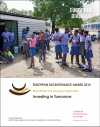Author: e-MFP
We are delighted to announce the launch of the European Microfinance Award 2017 with its €100,000 prize, this year on Microfinance for Housing, all details of which can be found on the Award website. Each year, e-MFP launches the European Microfinance Award, in conjunction with the Luxembourg Ministry of Foreign and European Affairs and the Inclusive Finance Network Luxembourg (InFiNe.lu). And like previous years with their focus on agriculture, social performance management, the environment, post-disaster and crisis contexts, or last year’s edition on Education, this year’s Award is looking for applications from financial institutions that are innovating, exploring and testing new ideas, that go beyond their core financial services, and exemplify the evolution of the microfinance sector beyond boilerplate microenterprise credit. Housing is a great example of how to do this. After the health and safety of children, there’s probably nothing more important to people everywhere than adequate housing. It is a core human need and a top investment priority for families anywhere. But 1.6 billion people live without adequate shelter. By 2030 this will have doubled and the need will be mostly in urban areas, where more than half of the world population lives today and where it is estimated that 2 billion people will be living in slums, where, almost by definition, substandard and unsafe housing is the norm.










0